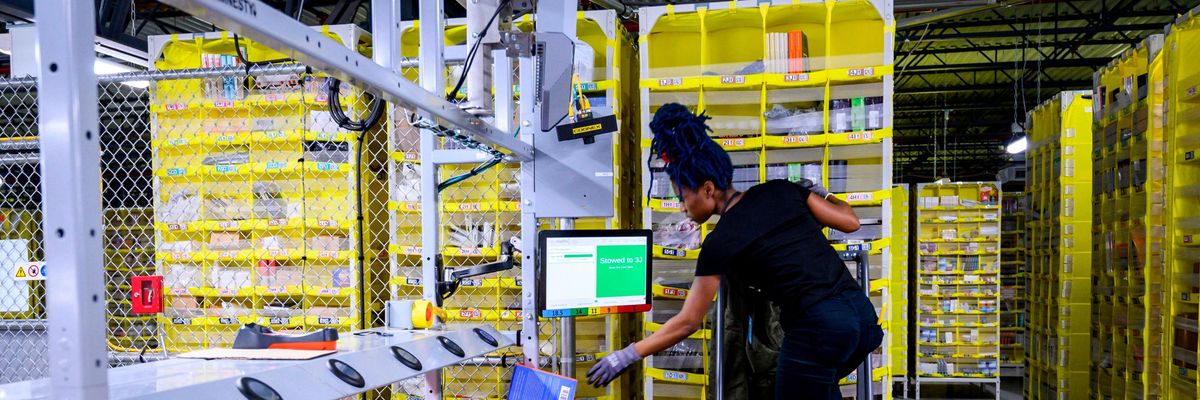As the United States' unionization movement elevates criticism of Amazon's labor conditions, an analysis published Tuesday exposed a 20% rise in injuries among company warehouse workers last year while a pandemic-related increase in online shopping led the e-commerce giant's profits to soar.
"While shareholders and executives reaped the benefits of the company's soaring stock price, Amazon's aggressive growth has come at a high cost for its workers."
The report--entitled The Injury Machine: How Amazon's Production System Hurts Workers--was published by the Strategic Organizing Center (SOC), a democratic coalition that includes the Communications Workers of America, International Brotherhood of Teamsters, Service Employees International Union, and United Farmworkers of America.
"Amazon's earnings in the first 12 months of the pandemic exceeded the previous three years combined," the report states, noting the company's profits jumped from $21.3 billion in 2020 to $33.4 billion in 2021.
"While shareholders and executives reaped the benefits of the company's soaring stock price, Amazon's aggressive growth has come at a high cost for its workers," the document adds. "Amazon's high-pressure operations keep resulting in worker injuries in unprecedented numbers, and the situation is worsening."
Based on data Amazon submitted to the Occupational Safety and Health Administration, SOC found that "in 2021, there were 38,334 total recordable injuries--defined as those requiring medical treatment beyond first aid or requiring time off a worker's regular job--at Amazon facilities."
"The vast majority of these were serious: 34,001, or 89%, of the injuries were categorized as either light duty or lost time injuries--that is, injuries where workers were hurt so badly that they were either unable to perform their regular job functions (light duty) or forced to miss work entirely (lost time)," the report points out.
The analysis emphasizes that the Seattle-based company's "injury rate over the last five years has been consistently high--above 7.4 injuries per 100 full-time equivalent workers (FTEs) in all but one year. The injury rate in 2021, 7.9 injuries per 100 workers, is the second-highest rate in the past five years and a sharp increase from 2020."
As the document details:
From 2017 to 2021, the only year that Amazon's injury rates declined, 2020, was the same year that Amazon temporarily eased its work speed pressures as part of its response to the Covid-19 pandemic by suspending disciplinary action against workers for underperformance on productivity metrics. However, in October 2020--just ahead of Prime Day--Amazon reimplemented its work rate, claiming to have "revised" its algorithms to accommodate Covid-related safety measures. Yet workers reported that the productivity pressures returned.
In a statement to Insider about the SOC's findings, Amazon spokesperson Kelly Nantel said that "we hired tens of thousands of additional people to help us meet the unforeseen demand from Covid-19 and people turning to Amazon to help them safely get products and supplies during the pandemic."
"Like other companies in the industry, we saw an increase in recordable injuries during this time from 2020 to 2021 as we trained so many new people," Nantel continued, noting that last year's figure is lower than 2019, which was just before the pandemic and featured Amazon's highest injury rate of the past five years.
Putting Amazon's figures into context, the SOC report explains that "in 2021, there were 7.7 injuries per 100 Amazon warehouse workers as compared to 4.0 injuries per 100 workers at all other warehouses" and the company's rate of serious injuries for such facilities "was 6.8 per 100 workers, as compared to 3.3 for all other employers in the warehouse industry."
Nantel said that "while we still have more work to do and won't be satisfied until we are excellent when it comes to safety, we continue to make measurable improvements in reducing injuries and keeping employees safe, and appreciate the work from all of our employees and safety teams who are contributing to this effort."
Before stepping down as CEO in April 2021, Amazon founder Jeff Bezos--one of the richest people on the planet--wrote in a letter to shareholders that along with being "Earth's Most Customer-Centric Company... we are going to be Earth's Best Employer and Earth's Safest Place to Work."
Citing that last pledge from Bezos' letter, the SOC document states that "in response to rising scrutiny of its safety record, Amazon has scrambled to launch a public relations campaign to attempt to convince the public it is taking safety seriously."
"The company claims to have invested millions of dollars in initiatives intended to promote safety. And Amazon declared in April 2021 that it aims to cut injury rates by 50% by 2025," the report says. "The SOC's analysis of Amazon's injury data for 2021 finds that the company has not only failed to make any progress on improving its injury rates, but has performed substantially worse than in the previous year, raising significant questions about Amazon management's commitment to preventing worker injuries."
The report comes as workers at a Staten Island warehouse celebrate a recent unionization vote that Amazon is trying to overturn. During a Monday call with leaders of the victorious Amazon Labor Union, Sen. Bernie Sanders (I-Vt.) declared that "all across this country, people are saying, 'Whoa! If these guys at Amazon can take on that company, we can do it as well.'"
The win for workers in New York City coincided with a second union vote at an Amazon facility in Bessemer, Alabama--the results of which remain contested. The Retail, Wholesale, and Department Store Union last week filed 21 objections with the National Labor Relations Board, accusing the retail giant of interfering with the organizing rights of workers at that location.

